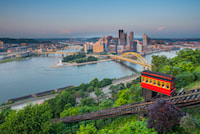History of Pittsburgh, Pennsylvania

Pittsburgh started its colorful history when Native Americans settled in the region of modern Pittsburgh. The British and French explorers found conjunction where Monongahela Rivers and the Allegheny meet. War took place in the area when the British and French fought for dominance. Britain overcame the French and won the battle.
The settlements surrounding Fort Pitt flourished after America became independent in 1783. The area witnessed the Whiskey Rebellion, where the farmers went against federal taxes on whiskey. Products from Britain were cut off following the War of 1812, which led the Americans to make their own production. Pittsburg began producing brass, iron, glass in 1815. After almost three decades, Pittsburgh had become one of the most significant towns in the region. By 1875, they started producing steel. After two years, one of the most violent riots in the area took place. The workers burned infrastructures and cars. Several workers died on that day.
Pittsburg was a fortified Republican party until 1932. They turned into a liberal stronghold after unemployment soared in the Great Depression and the establishment of labor unions around the 1930s. The town was at the heart of the "Arsenal of Democracy" in WWII. The city produced ammunitions as part of the war efforts. It was also this time when Pittsburgh began to bounce back from economic decline.
After World War II, "Renaissance" was inaugurated in Pittsburgh. Renaissance is clean air and civic restoration effort. The commercial and industrial aspects of the economy continued to grow strong through 1960. But in 1970, the steel industry began to decline as foreign competition became tough. Many workers lost their jobs as mills began to close. In the 1980s, many of the top companies in Pittsburgh relocated. Pittsburgh was no longer a major transportation city in 2007. The city has a total population of more than 2 million. More than 50% of the population is of European descent, and the rest are minorities.
In spite of the economic decline in Pittsburgh, civic improvements persisted. The Pittsburgh History and Landmarks Foundation, together with Ziegler Jr., believed that they could utilize historic preservation to improve the economy. They acquired the terminal buildings and a 1-mile property in the city and developed it as historic adaptive development. They were given help by the Allegheny Foundation to make the vision possible. Landmarks acquired other more buildings for different uses and added a hotel, and parking areas.
At present, Pittsburgh is a diverse city with a steady economy and a low cost of living. The city is vibrant with buildings and institutions for culture and education. Pittsburgh has been recognized for being one of the most livable cities in the world. Just recently, tourism has begun to flourish as new hotels became operational since 2004. The new hotels boast of more rooms than its neighboring cities. The city has also become a choice for many multinational companies such as Apple, Google, and Uber. Further, Pittsburgh is now a major influence in green environmental design. Immigrants, especially Asians, begin to settle in the city.
Learn more
The settlements surrounding Fort Pitt flourished after America became independent in 1783. The area witnessed the Whiskey Rebellion, where the farmers went against federal taxes on whiskey. Products from Britain were cut off following the War of 1812, which led the Americans to make their own production. Pittsburg began producing brass, iron, glass in 1815. After almost three decades, Pittsburgh had become one of the most significant towns in the region. By 1875, they started producing steel. After two years, one of the most violent riots in the area took place. The workers burned infrastructures and cars. Several workers died on that day.
Pittsburg was a fortified Republican party until 1932. They turned into a liberal stronghold after unemployment soared in the Great Depression and the establishment of labor unions around the 1930s. The town was at the heart of the "Arsenal of Democracy" in WWII. The city produced ammunitions as part of the war efforts. It was also this time when Pittsburgh began to bounce back from economic decline.
After World War II, "Renaissance" was inaugurated in Pittsburgh. Renaissance is clean air and civic restoration effort. The commercial and industrial aspects of the economy continued to grow strong through 1960. But in 1970, the steel industry began to decline as foreign competition became tough. Many workers lost their jobs as mills began to close. In the 1980s, many of the top companies in Pittsburgh relocated. Pittsburgh was no longer a major transportation city in 2007. The city has a total population of more than 2 million. More than 50% of the population is of European descent, and the rest are minorities.
In spite of the economic decline in Pittsburgh, civic improvements persisted. The Pittsburgh History and Landmarks Foundation, together with Ziegler Jr., believed that they could utilize historic preservation to improve the economy. They acquired the terminal buildings and a 1-mile property in the city and developed it as historic adaptive development. They were given help by the Allegheny Foundation to make the vision possible. Landmarks acquired other more buildings for different uses and added a hotel, and parking areas.
At present, Pittsburgh is a diverse city with a steady economy and a low cost of living. The city is vibrant with buildings and institutions for culture and education. Pittsburgh has been recognized for being one of the most livable cities in the world. Just recently, tourism has begun to flourish as new hotels became operational since 2004. The new hotels boast of more rooms than its neighboring cities. The city has also become a choice for many multinational companies such as Apple, Google, and Uber. Further, Pittsburgh is now a major influence in green environmental design. Immigrants, especially Asians, begin to settle in the city.
Learn more